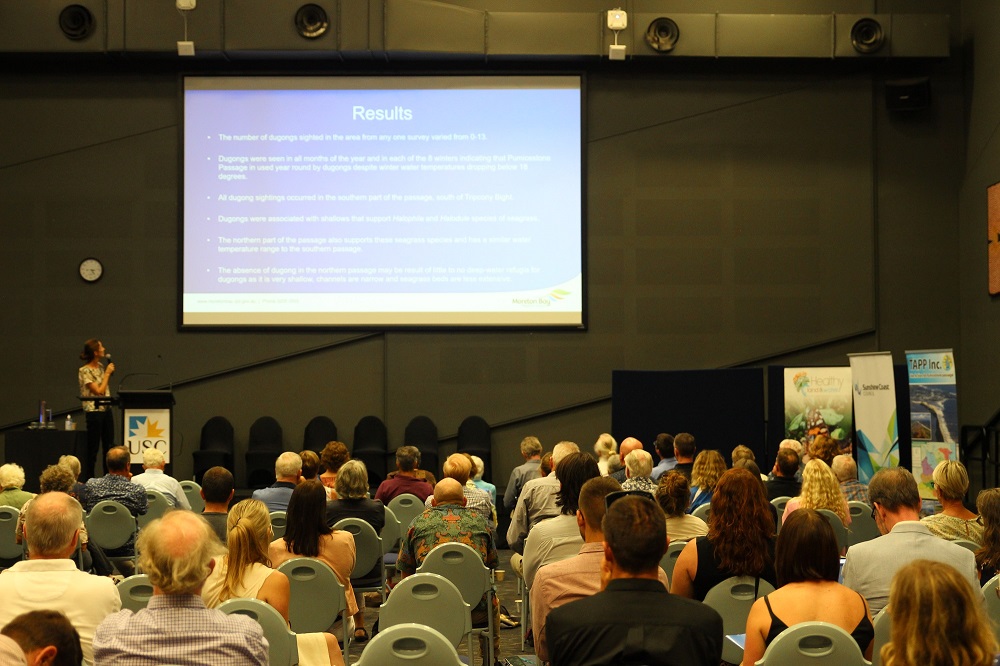
From dune rehabilitation to shellfish reef restoration: Pumicestone Catchment Convergence wrapped up
Passionate community members, Traditional Owners, researchers, farmers, consultants, and government and industry representatives have enjoyed two days of presentations followed by a collaborative planning session at the Pumicestone Catchment Convergence 2021: Insights for a healthy future.
 Jessica Mowat (Moreton Bay Regional Council) presenting on day 1 of the Pumicestone Catchment Convergence.
Jessica Mowat (Moreton Bay Regional Council) presenting on day 1 of the Pumicestone Catchment Convergence.
Research findings across the catchment
The Convergence showcased the remarkable breadth of research and action that has taken place across the catchment and the knowledge that has been gained since the last Pumicestone Science Conference in 2011.
The event also helped celebrate the 50th anniversary of the signing of the Ramsar Convention for the Protection of International Wetlands in 1971 by highlighting the outstanding ecological values of the Pumicestone Passage as part of the Moreton Bay Ramsar Wetland.
The organising group responsible for delivering the Convergence included the Moreton Bay Regional Council, Sunshine Coast Council, the University of the Sunshine Coast, Take Action for Pumicestone Passage (TAPP), and the Wildlife Preservation Society of Queensland – Sunshine Coast branch, and Healthy Land & Water as facilitator.
The Convergence was a continuation of a long history of effective integrated catchment management approaches in the Pumicestone catchment.
Telling the story was an impressive line-up of over 50 speakers who donated their time to contribute wisdom, expertise, and know-how to help conserve and restore the catchment.
Engaging speakers covered a broad range of topics from dugongs to horticulture, cultural landscape mapping to shellfish reef restoration, and seagrass monitoring to Constructed Floating Wetlands.
Information about traditional ecological knowledge, community science and stewardship, agricultural knowledge and practice, marine and terrestrial habitat and species, climate change impacts and adaptation, and sustainable development were shared.
The event’s keynote speaker, Mike Ronan, Manager of Wetlands at the Department of Environment and Science, set the scene for the conference, walking attendees through the ecological values of the very unique Pumicestone Passage and its catchment.
Mike described the catchment’s complex groundwater-dependent ecosystem and explained how every part of the ecosystem is connected and the impact each part has on another.
Over the first two days, presenters shared their research findings, provided updates on their projects in the area, and shared their knowledge and insights into the area.
The third day was dedicated to a collective planning session to collate the learnings from the conference and then review the Pumicestone Catchment Action Plan and SEQ NRM Plan, identify research gaps, and reinforce partnerships for cohesive management.
A key theme coming through many of the presentations was that the actions taken now can impact the health of the area long into the future.
The successful event was run by a dedicated group, committed to the protection and enhancement of the richly diverse catchment, including the unique Pumicestone Passage. The event was funded by a number of supportive sponsors.
This project is supported by Healthy Land & Water through funding from the Australian Government’s National Landcare Program.
The Convergence was supported by Take Action for Pumicestone Passage through funding from the Sunshine Coast Council, by the Bribie Island Environmental Protection Association through the Moreton Bay Regional Council, and by the Sunshine Coast Council directly.



